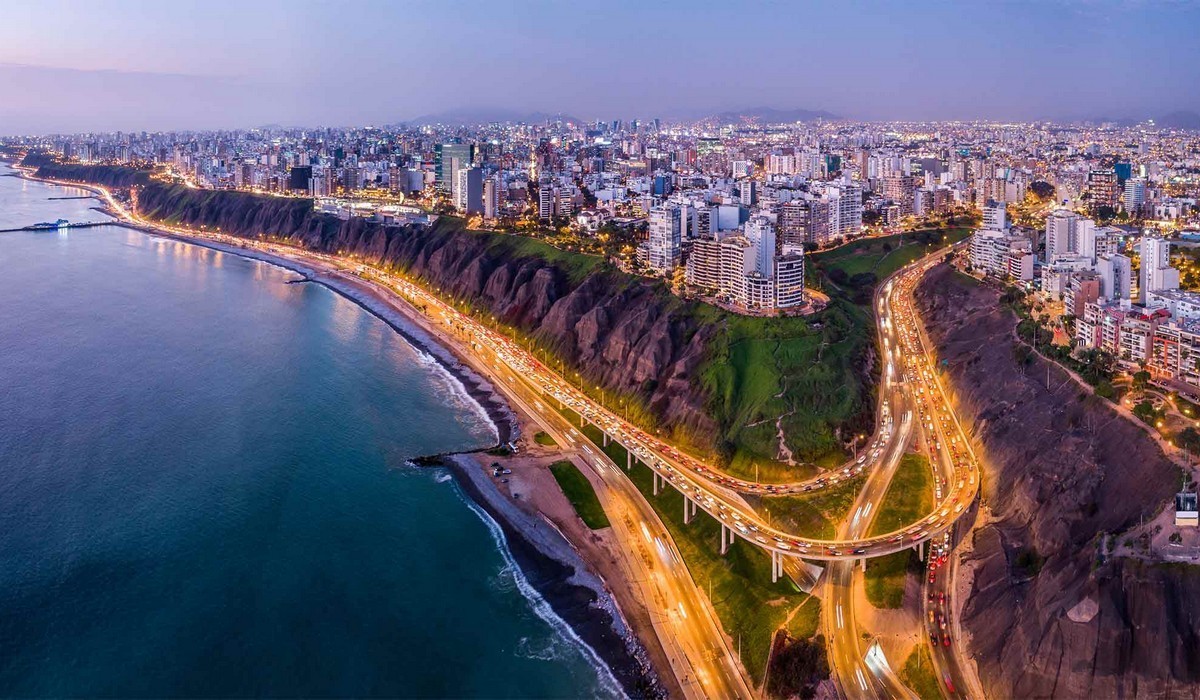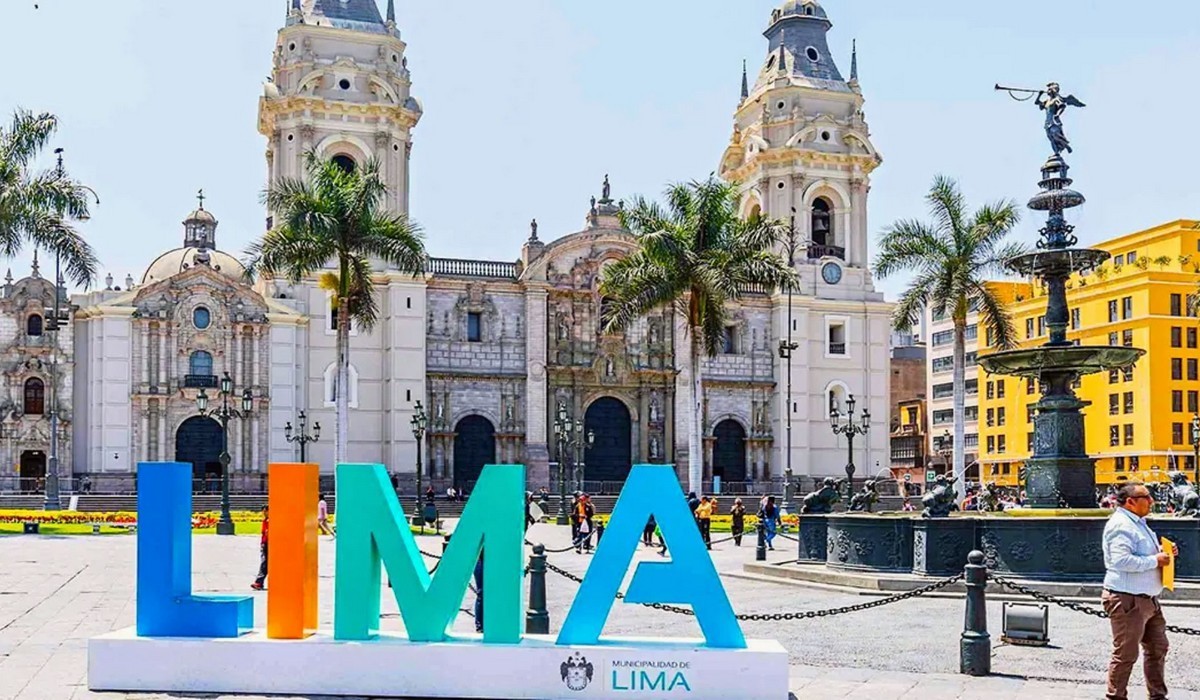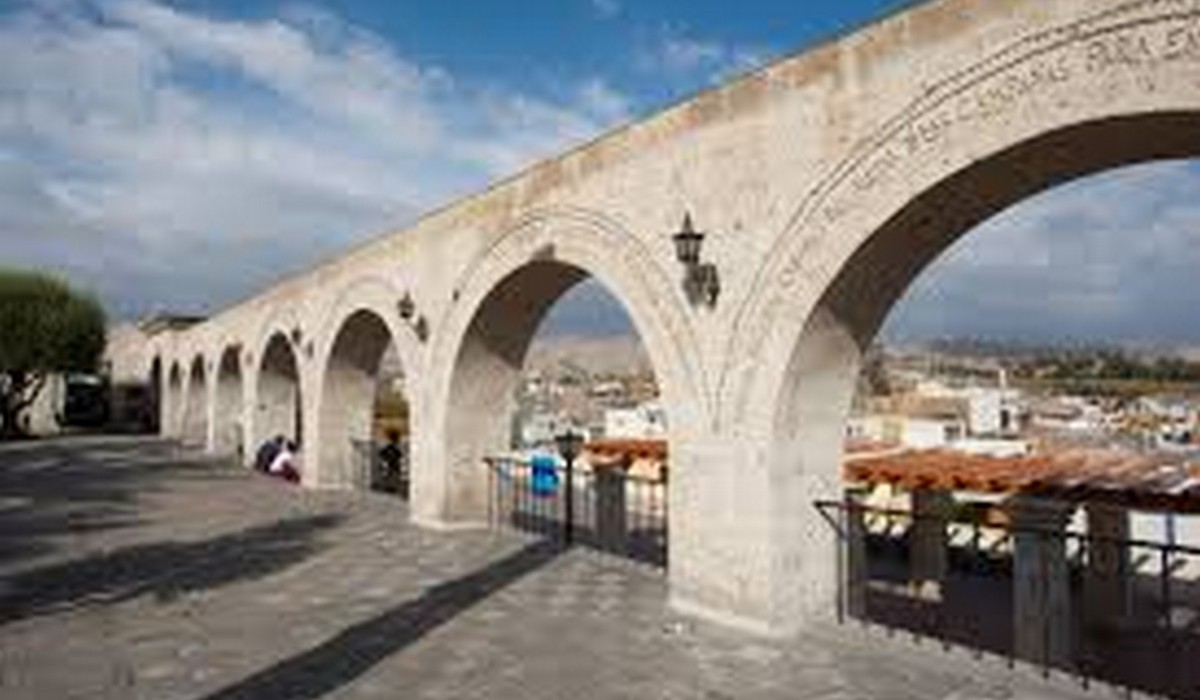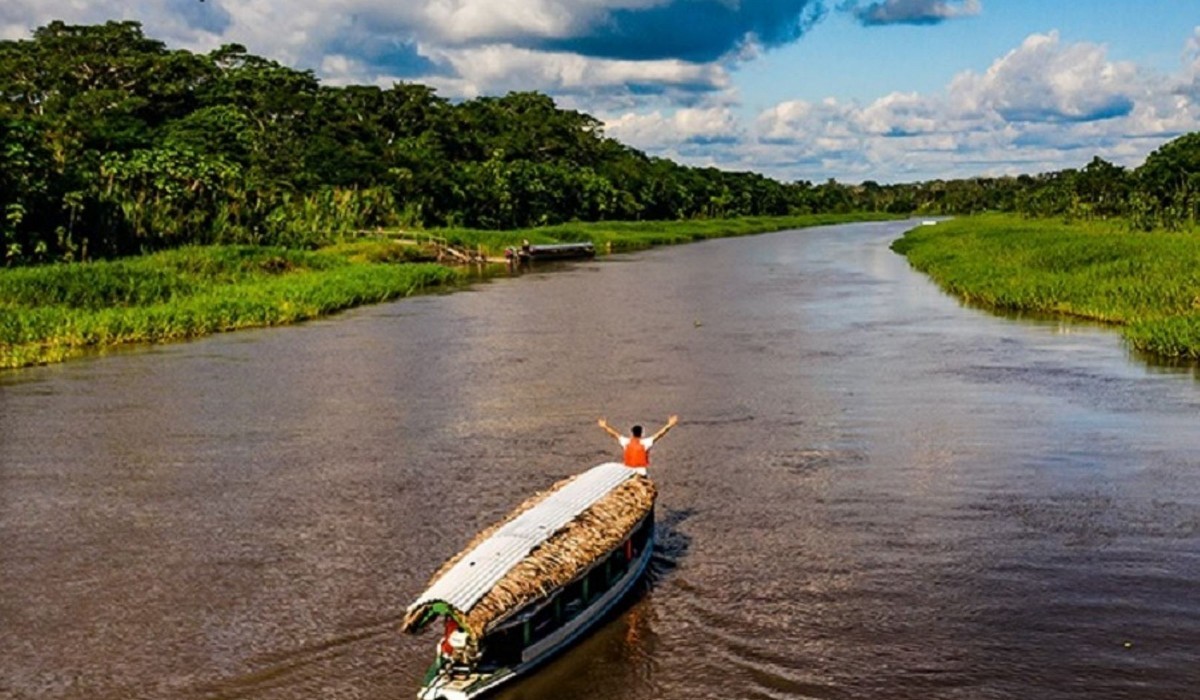Lima, officially, according to the Constitution, City of Lima,11 is the capital of the Republic of Peru.12 It is located on the central coast of the country, on the shores of the Pacific Ocean, integrating an extensive and populated urban area, flanked by the desert coastal and extended over the valleys of the Chillón, Rímac and Lurín rivers.
The 2022 census projection established a population of 13,943,800 inhabitants, a figure that makes it the most populous city in the country.1 The urban conglomerate made up of Lima and Callao, on the other hand, groups a population of 11,098,000 inhabitants1 distributed in fifty districts, where the province of Lima concentrates forty-three districts and the province of Callao, seven districts. The urban agglomeration is organized in cones or axes of the city: North Lima, South Lima, East Lima and Central Lima.
At present, it is considered the political, economic, industrial, cultural, financial and commercial center of the country. Internationally, it is the fifth largest city in Latin America, the fourth by GDP, the fifth by number of inhabitants, and one of the thirty most populous urban agglomerations in the world.13 Due to its geostrategic importance, it has been defined as a city global “beta+ class”.14
On January 18, 1535, it was founded under the name of Ciudad de los Reyes by the Spanish conquistador Francisco Pizarro within the agricultural region known by the coastal natives as Limac, later as Lima, a name that it acquired over time.15 It was the Capital of the Viceroyalty of Peru due to its valleys and its low altitude above sea level, replacing Jauja, which is located in the heights of the Andes.
The viceroyalty, at the time, served as the most important administrative entity of the Hispanic Monarchy within South America, while Lima, in turn, was the largest and most important city in all of South America during the colonial period. After the independence process, it became the capital of the free departments and, later, of the Peruvian Republic.16 It was the capital of the North-Peruvian State. Lima is the seat of the oldest institution of higher education in the New World, the Universidad Nacional Mayor de San Marcos, founded on May 12, 1551 during the Spanish vice regal regime; it is the oldest, most recognized and most important university in Peru. 17 In addition, the first officially founded and the oldest continuously operating in America.1819
In October 2013, Lima was chosen to host the 2019 Pan American Games. It also hosted the United Nations Conference on Climate Change in the 2014 edition, hosted the APEC world forum in the 2008 and 2016 editions, in the Annual Meetings of the International Monetary Fund and the World Bank Group in October 2015, the Miss Universe 1982 pageant and is scheduled to host the 2023 U-17 Soccer World Cup.
HISTORY
Lima is the capital and the largest city of Peru. Founded in 1535 by the Spanish conquistador Francisco Pizarro, Lima has grown into a city with a rich and fascinating history that spans more than five centuries.
Before the Spanish conquest, the Lima region was inhabited by various pre-Columbian cultures, including the Lima culture, the Wari culture, and the Ichma culture. The Incas conquered the region at the end of the 15th century, but the Inca presence in the region was brief and did not leave a significant mark on the city.
In 1532, Francisco Pizarro arrived in Peru with the intention of conquering the Inca Empire. In 1533, Pizarro captured the Inca emperor Atahualpa and in 1535 he founded the city of Lima on the Pacific coast. Lima became the capital of the Viceroyalty of Peru and the most important administrative and commercial center of South America during the colonial era.
During the colonial era, Lima experienced great growth and many important buildings were built, including the Cathedral of Lima and the Monastery of San Francisco. The city became a cultural and artistic center and many writers, artists and intellectuals gathered in the city to exchange ideas and discuss the political events of the day.
In 1821, Peru declared its independence from Spain and Lima became the capital of the new republic. During the Republican era, Lima continued to grow and develop. New roads, bridges, hospitals and schools were built, and new neighborhoods and districts were created. In the 1920s, Lima experienced an economic boom due to the export of rubber, cotton, and oil.
In the 1980s, Lima became the center of the war against the Shining Path guerrilla group. The city suffered several terrorist attacks and the violence affected the economy and the daily life of the city. However, in recent decades, Lima has experienced a renaissance and has become a modern and vibrant city.
Today, Lima is a cosmopolitan and diverse city, with a population of more than 10 million inhabitants. The city has numerous museums, theaters, art galleries, and restaurants, and is known for its delicious Peruvian food. Lima is also famous for its beautiful colonial buildings and impressive modern architecture, making it one of the most interesting and fascinating cities in South America.
GEOGRAPHY – LOCATION
Lima is located in the coastal desert of Peru, in the foothills of the western slope of the central Andes of Peru. Although it was initially founded on the valley of the Rímac river, today it extends over extensive desert areas and even over other valleys such as the Chillón and Lurín rivers.
It borders the coast from km 50 of the Panamericana Norte, on the border of the district of Ancón with the province of Huaral; up to km 70 of the Panamericana Sur, on the border of the district of Pucusana with the province of Cañete; that add up to an extension of just over 130 km of coastline and beach. Towards the east, it extends approximately to kilometer 37 of the Central highway, on the border of the district of Lurigancho-Chosica with the province of Huarochirí.
RELIEF
In terms of morphology, the department of Lima is made up of two distinct regions, the coast and the more.83 In the coastal area, desert pampas predominate, framed by hills, 84 in many cases interrupted by rain formed by rivers that carry water all year. These are the coastal valleys, where cities are settled and agriculture prospers.84 the most important features are isolated hills or forming systems, dry ravines, fluvial and marine terraces, and undulating reliefs, as well as coastal cliffs. The Sierra region is formed by the Western Cordillera of the Andes, with heights that reach more than 6000 m a.s.l. no. m.84.
HYDROGRAPHY
The Rímac river seen from the Tacna Bridge.
For its water supply, the population of Lima depends on three rivers: Rímac, Chillón and Lurín.85 Like most Peruvian rivers, they originate in the high mountains of the Andes and flow into the Pacific Ocean.86 They are short, with a steep course and a seasonal regime.87 The Rímac River begins its journey on the western slope of the Andes mountain range at an altitude of approximately 5,508 m at the Paca mountain,88 running through the provinces of Lima and Huarochiri, both located in the department of Lima.
At the height of the city of Lima, the river is crossed by several bridges, the most representative being the Puente de Piedra built by Viceroy Juan de Mendoza y Luna in 1610. The water treatment plant is located in its basin. La Atarjea (managed by the state company Sedapal), in addition to the hydroelectric plants of Huampaní, Matucana, Huinco, Barbablanca and Moyopampa.
The Chillón River is the second most important source of water for Lima.89 It forms on the western slope of the La Viuda mountain range. Its basin covers an area of 2,444 km².85 Its valley is fertile, as evidenced by the presence of various human settlements from pre-Hispanic times to the present. It was here that the colli culture was formed. In addition, the Chivateros culture was established in the valley formed by this river.90
The Lurín River originates in the glaciers and lagoons of the western Andes. Its basin covers an area of 1,670 km² and extends from the edge of the coastline to the area of the snow-capped Otoshmicumán and Chanape mountains in the province of Huarochiri.91 It is known as the Chalilla river up to its confluence with the Taquía stream from where it receives their common name. Its main tributaries are the Taquía, Llacomayqui, Tinajas, Numincancha and Canchahuara on its left bank and the Chamacna on the right.
TOURISM
As the main point of entry into the country, Lima has developed an important tourism industry, among which its historic center, its archaeological centers, its nightlife, museums, art galleries, festivities and popular traditions stand out. Lima is currently leading the index of most visited cities in Latin America and is in the top 20 globally, with 5.11 million visitors in 2014.
The historic center of Lima, which includes part of the districts of Lima and Rímac, was declared a World Heritage Site by Unesco in 1988 due to the importance that the city had during the Viceroyalty of Peru, leaving as testimony a large number of architectural legacies.129 The Basilica and Convent of San Francisco, the Plaza Mayor, the Cathedral of Lima, the Basilica and Convent of Santo Domingo, the Torre Tagle Palace, among others, stand out. The tour of the city’s churches is very popular among tourists. In a short tour of the city center we can find many, several of which date from the 16th and 17th centuries.
Among them, the Cathedral of Lima and the Basilica of San Francisco stand out, of which it is said that they are linked by the underground passages of their catacombs.130 The Sanctuary and Monastery of Las Nazarenas also stands out, a place of pilgrimage to the Lord of Miracles , whose festivities in the month of October constitute the most important religious manifestation of Lima and of all Peruvians. Some sections of the viceregal walls of Lima can still be seen: such is the case of the Baluarte Santa Lucía, remains of the old Spanish fortification built by the viceroy Melchor de Navarra y Rocafull around the city center, whose location adjoins the limit from the Barrios Altos and El Agustino.
Likewise, having Lima the privilege of being the only capital of South America with immediate access to the sea, it has large tourist boardwalks that in recent years have become a great attraction for thousands of tourists, especially in the districts of Miraflores and Barranco, where There is also a wide development in entertainment in these areas, turning the capital into a place with several places of tourism and entertainment.
Until the 1970s, the hotel offer was characterized by having the best hotels in the city in the center of Lima, however, from the beginning of the 1990s to date these establishments have positioned themselves in other areas such as the downtown area. South of the capital such as Miraflores, Barranco, Santiago de Surco, Surquillo and San Borja; in addition to the district of San Isidro that has the largest hotel building in Peru, the 30-story Westin Libertador.
Hotel Westin Libertador, with 30 floors and 120 meters high, was for a time the tallest building in the city.
These fine examples of Spanish medieval fortifications were used to defend the city from attacks by pirates and corsairs.133 For this, part of the wall corresponding to the area behind the Church of San Francisco, very close to the Government Palace, was recovered. in which a park (called Parque de la Muralla) was built and in which remains of it can be seen.134 Half an hour from the historic center, in the Miraflores district, you can visit the tourist and entertainment center Larcomar el which is located on the cliffs facing the sea.
Huaca Pucllana, archaeological site located in the district of Miraflores.
The city has two traditional zoos: the main and oldest one is the Parque de las Leyendas, located in the San Miguel district, and the other is the Huachipa Zoological Park located to the east of the city in the Lurigancho-Chosica district. . On the other hand, the offer of cinemas is wide and has numerous state-of-the-art rooms (4D) that program international film premieres.
Exclusive beaches are visited during the summer months, which are located on the Pan-American highway, to the north are the resorts of Santa Rosa and Ancón; The latter was until the eighties the most exclusive in Lima and Peru. Currently, although it maintains its architectural beauty, it is visited by people from all parts of Lima Norte and Centro.135 And to the south of the city, the resorts of Punta Hermosa, Punta Negra, San Bartolo and Pucusana. Numerous restaurants, discos, lounges, bars, clubs, and hotels have been opened in such places to cater to bathers.
The suburban district of Cieneguilla, the district of Pachacámac and the district of Chosica provide important tourist attractions among locals. Due to its elevation (over 500 m.a.s.l.), the sun shines in Chosica during the winter, and it is highly visited by Lima residents to escape the urban fog.
GASTRONOMY
Lima cuisine has been the product of the fusion of the culinary tradition of ancient Peru with Spanish cuisine in its most strongly influenced variant by the Moorish presence in the Iberian Peninsula and with important contributions from culinary customs brought from the Atlantic coast of Sub-Saharan Africa. for the slaves. Subsequently, this miscegenation was influenced by the culinary uses and customs of French chefs who fled the revolution in their country to settle, in good numbers, in the capital of the Viceroyalty of Peru.
Equally transcendental was the influence of 19th century immigration, which included Cantonese Chinese, Japanese and Italians,203 among other mainly European origins, as well as a strong internal flow from rural areas to the cities, particularly to Lima in the second half of the 20th century.204 The city also has a wide variety of Creole food restaurants, chifa, cebicherías and chicken shops. Peruvian cuisine, widely represented in Lima, has several Guinness Records for its diversity and quality.205 In 2006, during the annual Madrid Fusion event, the city was declared the Gastronomic Capital of Latin America.206
MUSEUMS
Museum of Italian Art in Lima.
The city concentrates the largest number of museums in the entire country, it has nearly fifty museums, including the National Museum of Archaeology, Anthropology and History of Peru, which among its most important collections houses an impressive sample of pre-Columbian textiles, the National Museum of Peruvian Culture and the Rafael Larco Herrera Archaeological Museum, located inside a viceregal mansion and which presents among its most outstanding attractions a fine collection of gold and silver from ancient Peru, the famous collection of erotic art and the deposits where the Visitors can appreciate 45,000 duly classified archaeological objects.
Both museums are located in the Pueblo Libre district and are connected by a pedestrian blue line that makes it easy to visit together. In Miraflores you can visit the Sala Museo Oro del Perú in Larcomar, which has a collection of pre-Columbian gold objects. There are also the site museums of Lima, Ancón, Pachacámac and the new National Museum in South Lima is under construction. Not only are there museums dedicated to exposing the manifestations of Peruvian pre-Hispanic culture, but there are also art, natural history, science, religious, and thematic museums. The Museum of Art of Lima, the Museum of Italian Art, the Museum of Natural History, the Museum of Electricity and the Postal and Philatelic Museum of Peru stand out. You can also visit some private collections open to the public such as the Gold Museum of Peru and Arms of the World.







